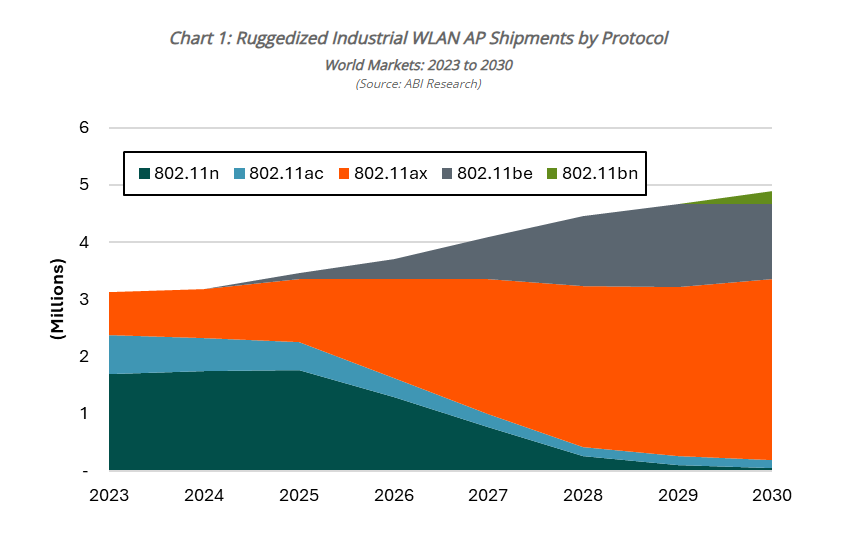Wireless Local Area Network (WLAN) solutions have historically struggled to gain traction in the industrial markets, with industrial organizations traditionally favoring tried and tested fixed cable over what they view as unreliable wireless. Yet recent technical advances in WLAN, including 802.11be (Wi-Fi 7), 802.11bn (Wi-Fi 8), and Standard Power 6 Gigahertz (6 GHz), are enabling WLAN to handle more complex and more demanding industrial tasks for the first time. Alongside this, industrial organizations are increasingly in need of WLAN to service the new mission-critical applications (e.g., Automated Guided Vehicles (AGVs) and Autonomous Mobile Robots (AMRs)) that depend upon wireless. These developments are helping to expand the addressable market for industrial WLAN, and ABI Research forecasts that annual ruggedized industrial WLAN Access Point (AP) shipments will increase from 3.2 million in 2024 to 4.9 million in 2030.
WLAN Technical Advancements
In the past, it was the limited roaming capabilities of WLAN and its inability to guarantee deterministic latency that hindered its adoption in industrial Operational Technology (OT) settings. However, WLAN’s technical shortcomings are slowly being overcome through a combination of progress in the 802.11 (Wi-Fi or WLAN) standards and industry competition as WLAN equipment vendors aim to differentiate themselves through innovation. Some of the key technical innovations and developments shaping industrial WLAN include the 6 GHz spectrum, Orthogonal Frequency-Division Multiple Access (OFDMA), mesh networking, and more.
- 802.11ax (Wi-Fi 6): The Wi-Fi 6 standard introduced many new features valuable in industrial networks, such as OFDMA, which facilitates the simultaneous communication of multiple devices using a single AP/router.
- 6 GHz: 6 GHz is critical because the newly released band is far less congested than other bands, improving network reliability. However, 6 GHz availability is dependent on the region an industrial firm operates in. Wi-Fi 6E is the first standard to support the 6 GHz spectrum.
- 802.11be (Wi-Fi 7): With features like Multi-Link Operation (MLO) and Multi-Resource Unit (Multi-RU) Puncturing, Wi-Fi 7 improves spectrum efficiency and reduces interference.
- 802.11bn (Wi-Fi 8): When Wi-Fi 8 development concludes, industrial firms can expect features such as multi-AP coordination, distributed MLO, and Hybrid Automatic Repeat Request (HARQ).
- Mesh Networking: Operational Technology (OT) departments appreciate the extra network redundancy provided by a mesh network. Moreover, mesh topologies automatically resolve network issues in real time to ensure uninterrupted connectivity.
- Convergence with 5G: Leveraging both a WLAN and a private cellular network allows you to get the best of both worlds. Where one connectivity type struggles, the other can fill in the gaps. Enterprises are accustomed to Wi-Fi’s ease of use and flexibility, but the technology is unsuitable for some applications. 5G should be used to improve mobility, extend range, and reduce latency rates. Learn more about the WLAN-5G convergence by reading this press release.
Wi-Fi 5 Gets Passed Over
Introduced 16 years ago, 802.11n (Wi-Fi 4) is still the main Wi-Fi standard used in industrial networking. ABI Research reports that over half of all ruggedized industrial WLAN APs shipped in 2023 supported Wi-Fi 4. This far exceeds the number of APs that support 802.11ac (22.3%) and 802.11ax (23.7%).
A notable WLAN trend is the minimal traction of 802.11ac (Wi-Fi 5) in the industrial space. The standard was introduced in 2013 and never held much ground because the new features that it introduced were not valuable in industrial networks. Indeed, many WLAN equipment vendors determined that the jump from Wi-Fi 4 to Wi-Fi 5 was not significant enough to be worth supporting. Combined with the fact that industrial networks have long refresh cycles (15 to 20 years), most WLAN vendors chose to wait for 802.11ax (Wi-Fi 6).
While Wi-Fi 4 is the predominant standard used in industrial WLAN today, this will not be the case by 2026, as ABI Research forecasts that shipments of Wi-Fi 6 supporting industrial WLAN APs will surpass those supporting Wi-Fi 4 in that year. 
Download Today: Industrial and Manufacturing Survey 1H 2024: Industrial WLAN
A Similar Story for Wi-Fi 7
ABI Research anticipates 802.11be (Wi-Fi 7) to experience a similar fate as Wi-Fi 5. Industrial organizations prioritize reliability and latency when it comes to networking solutions, while Wi-Fi 7 is more focused on delivering “ultra-high throughputs.” This mismatch makes it less likely that industrial enterprises will seek 802.11be products.
Timing is another challenge hindering the potential for industrial Wi-Fi 7. Network equipment vendors are only now beginning to provide widespread support for the Wi-Fi 6 standard in the industrial space. Vendors will want to wait at least 3 to 5 years and achieve profibitality before committing significant time and resources for Wi-Fi 7.
With Wi-Fi 8 (802.11bn) right around the corner, this puts Wi-Fi 7 in a tough position. It’s unlikely that Wi-Fi 7 equipment will hit the mainstream for OT environments by the planned 2028 release of Wi-Fi 8. Considering that Wi-Fi 8 has more industrial-friendly features, ABI Research expects that many WLAN vendors will simply jump straight from Wi-Fi 6 to Wi-Fi 8 support.
The Next Generation of Industrial Wi-Fi
The future of industrial Wi-Fi is bound to be a lot different than what it is today. Industrial companies are contending with various OT challenges, notably the drive to reduce operating costs, the inability to source experienced engineers, the migration to new end-to-end solutions, and the increased complexity of OT environments. Concurrently, WLAN equipment vendors are shifting their approach to catering to industrial companies. For example, vendors like Moxa and Huawei are designing more compact Wi-Fi equipment to provide the versatility needed for mounting onto mobile robots.
In its Industrial WLAN Infrastructure Opportunities and Challenges report, ABI Research covers the latest trends shaping industrial WLAN. Moreover, it identifies the actions that industrial organizations can take to address emerging OT challenges. Download the report today!


